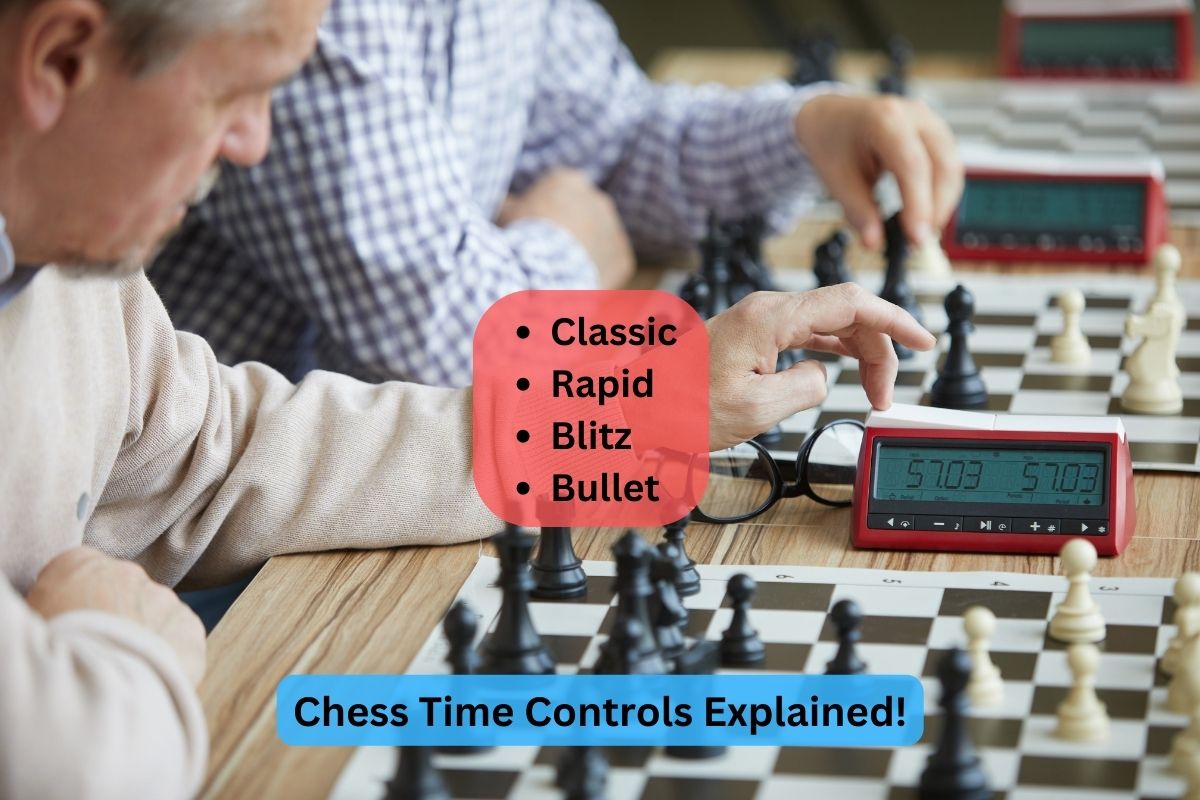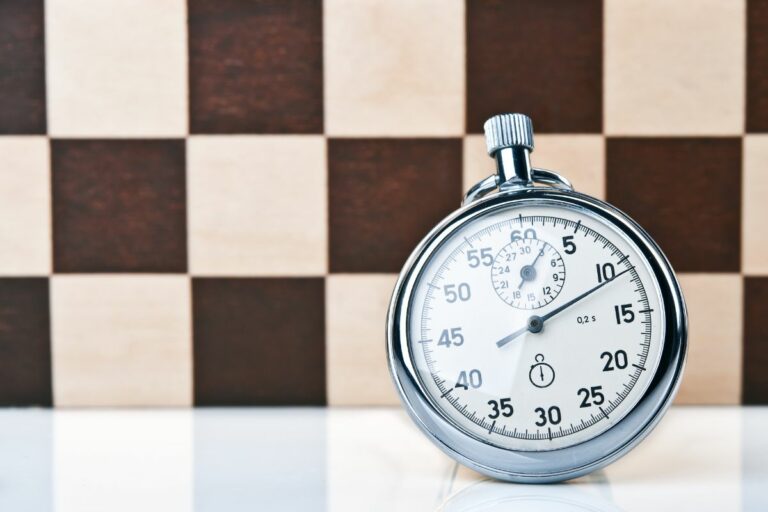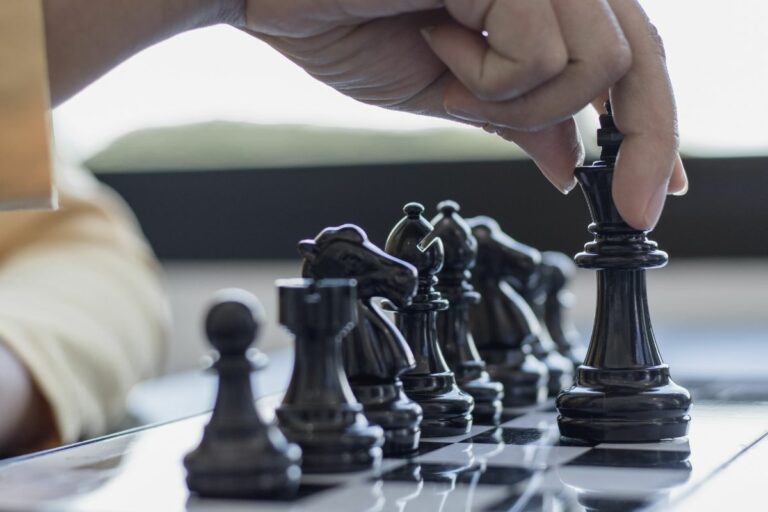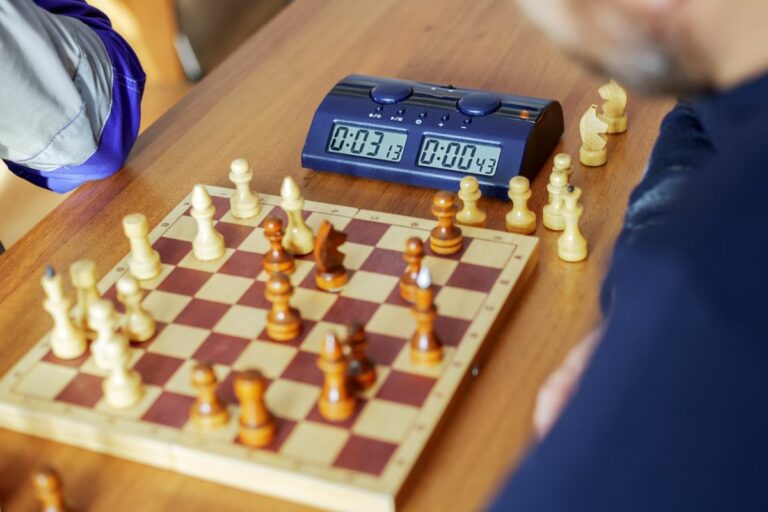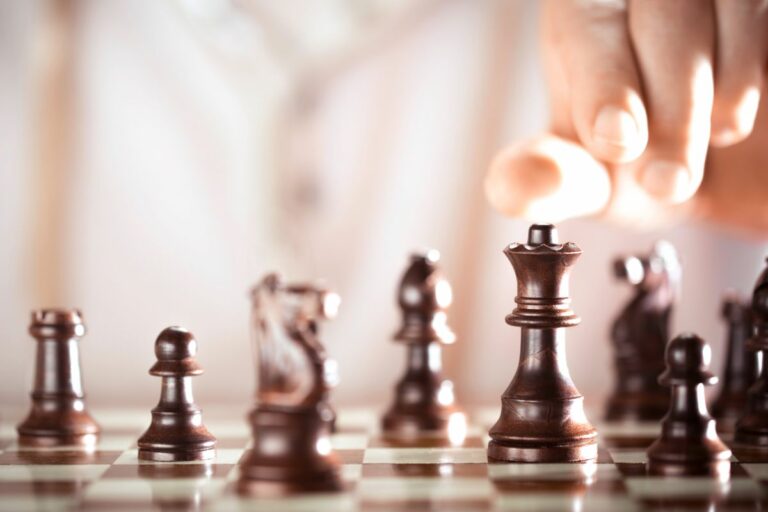Chess Time Controls – A Complete (Simple) Guide for Beginners
Time controls are one of the basics of professional tournament chess that every chess player must understand very well, and it’s one of the very few factors outside of the chess board where your understanding, control, and mastery of it will have a direct impact on the game.
However, it’s also one of the most confusing things for new chess players.
So, what are chess time controls? Whether you’re playing casually or competitively, understanding time controls is essential to enhancing your skills.
Chess time controls are rules that determine the amount of time players have to make their moves to ensure the game doesn’t go on indefinitely and add an element of strategic decision-making under limited time pressure. Different time controls in chess include classic, rapid, blitz, and bullet.
Keep reading to learn more about the different types of time controls in chess and how they work.
What Are Chess Time Controls?
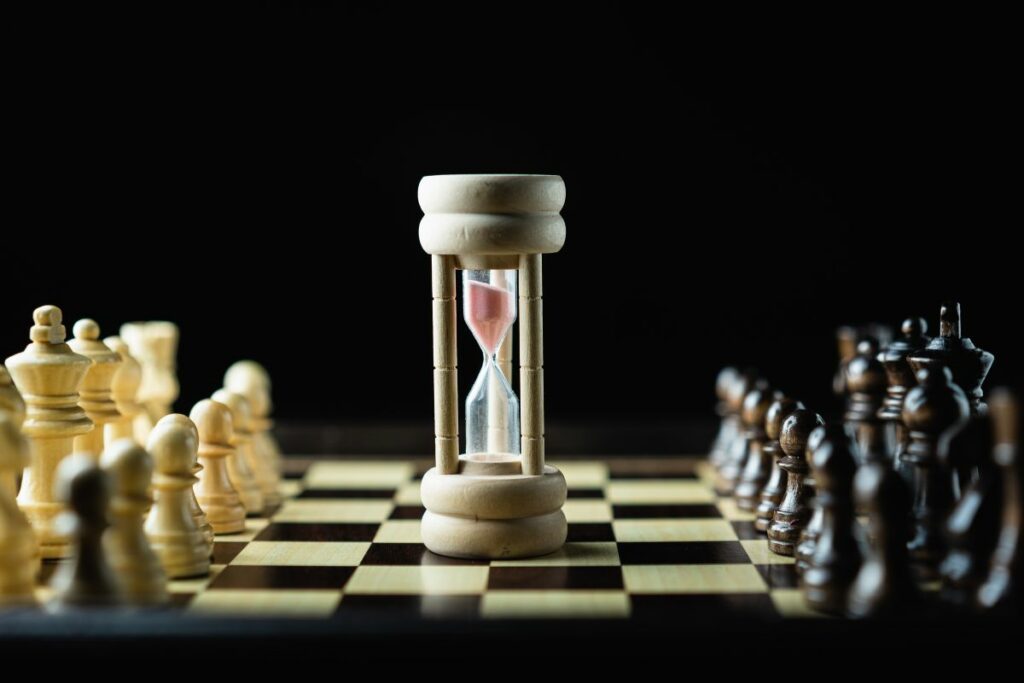
Chess time controls refer to the rules and regulations that determine the amount of time each player has to make their moves during a game. They are essential in competitive chess as they ensure that games progress at a reasonable pace and prevent players from excessively delaying the game.
The concept of time controls in chess originated in the mid-19th century when competitive chess tournaments began to gain popularity. Prior to that, players were free to take as much time as they needed for each move, resulting in matches that could last for hours or even days.
This lack of time restrictions proved impractical for organizing tournaments and maintaining a timely schedule. To address this issue, various methods of time control were introduced over the years.
The first notable time control system was the “hourglass” system, which involved using an actual hourglass or sand timer to measure the time taken by each player.
Players would have a fixed amount of time, typically an hour, to complete all of their moves. The hourglass would be turned over after each move, and when a player’s time ran out, they would lose the game.
As chess continued to evolve, digital clocks and time controls with increment or delay options were introduced. These modern time control systems revolutionized competitive chess, allowing for greater flexibility and precision in managing players’ time.
Please keep in mind that almost all of the examples I’ll provide in this article are FIDE time controls according to their Handbook here. The USCF and other organizations also use very similar time controls, but not always the same. Anyway, the logic in all are the same, so if you understand one you will understand all the others.
Different Time Controls in Chess
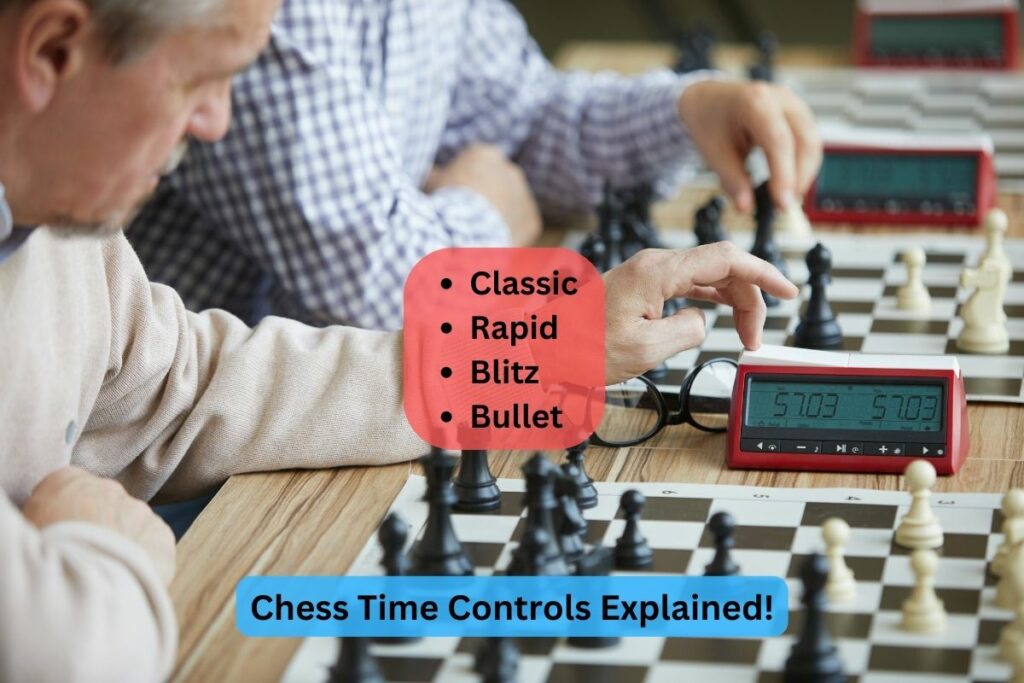
Different time controls in chess offer varying levels of time per player, influencing the pace and dynamics of the game. Let’s delve into each of these time controls in detail:
Classic Time Control
Also known as “standard” time control, this format provides a substantial amount of time to each player. It typically ranges from 90 minutes to a few hours for the entire game, with additional increments after each move.
Classic time controls allow players to delve deeply into the position, analyze various plans, and execute long-term strategies.
The most common classic time control used today and the one used by FIDE for all its major events is the 90+30+30 time control:
Classical FIDE Time Control: Each player gets 90 minutes to play their first 40 moves followed by an extra 30 minutes to finish the game with an extra 30 seconds added to the clock with each move.
Rapid Time Control
Rapid chess emphasizes a faster pace compared to classic time control. Players are allotted a significantly reduced amount of time, typically ranging from 10 to 60 minutes per player for the entire game.
The rapid format demands quicker decision-making and often leads to more tactical and dynamic gameplay. Rapid chess is popular for both over-the-board and online tournaments.
Rapid FIDE Time Control: Each player gets 15 minutes for the entire game and an extra 10 seconds added to the clock with every move starting at move 1
Blitz Time Control
Blitz chess takes speed to another level. In this format, players have very limited time to complete their moves, usually ranging from 3 to 10 minutes per player.
With such time constraints, players must think on their feet, rely on intuition, and react swiftly to their opponent’s moves.
Blitz games tend to be highly energetic and intense, relying more on pattern recognition and instinct.
Blitz FIDE Time Control: Each player gets 3 minutes for the entire game with an extra 2 seconds added to the clock with every move starting at move 1
Other popular blitz time controls are 5+3, 5+5, and 5+0.
Bullet Time Control
Bullet chess is the fastest time control in regular play. With extremely limited time, usually around 1 to 3 minutes per player, players must make their moves rapidly, often relying on pre-memorized openings and fast calculations.
Bullet games are lightning-fast and require exceptional speed, accuracy, and the ability to make quick decisions under severe time pressure. Bullet chess is so fast that actual over-the-board bullet chess matches are very rare, and instead, almost all bullet chess matches are played online (but you need a very good internet connection with a minimal lag).
Bullet FIDE Time Control: Each player gets 1 minute for the entire game. No increments.
As you can see, each time control has its own unique characteristics, influencing the strategies and playing styles of participants.
Chess Time Controls in a Nutshell
Now here is the table with the time controls:
| Time Control | Time Control Range | Most Common Time Used | Thinking |
|---|---|---|---|
| Classic | Over 60 minutes | 90 minutes for 40 moves then 30 minutes to finish game | The deepest you can think |
| Rapid | 10 to 60 minutes | 15 minutes +10 seconds increment | Some thinking is possible |
| Blitz | 3 to 10 minutes | 3 minutes +2 second increment | Only calculate tactics, fast |
| Bullet | Less than 3 minutes | 1 minute | No thinking, intuition only! |
Sudden Death Definition in Chess Time Controls
Sudden death time controls favor faster players and are very helpful to tournament organizers as they allow them to schedule the times of the rounds perfectly because they eliminate the possibility of a single match going on for too long.
However, most chess players think sudden death time controls are not fair in chess and the matter is very controversial today.
What do you think? Let me know in the comments!
Which Time Control is Used in Chess Tournaments?

Chess tournaments typically utilize a variety of time controls, depending on the level and format of the competition.
Higher-level tournaments tend to adopt longer time controls, allowing players to showcase their strategic depth and analytical skills.
However, rapid and blitz time controls are often implemented for faster-paced events or time-constrained tournaments to accommodate the schedule and create a dynamic playing environment.
Faster time controls are also used as tiebreaks in important events like the World Chess Championship, and they often are the decisive games in the match since most WCC matches end in draws.
How Is Time Measured During Chess Games?
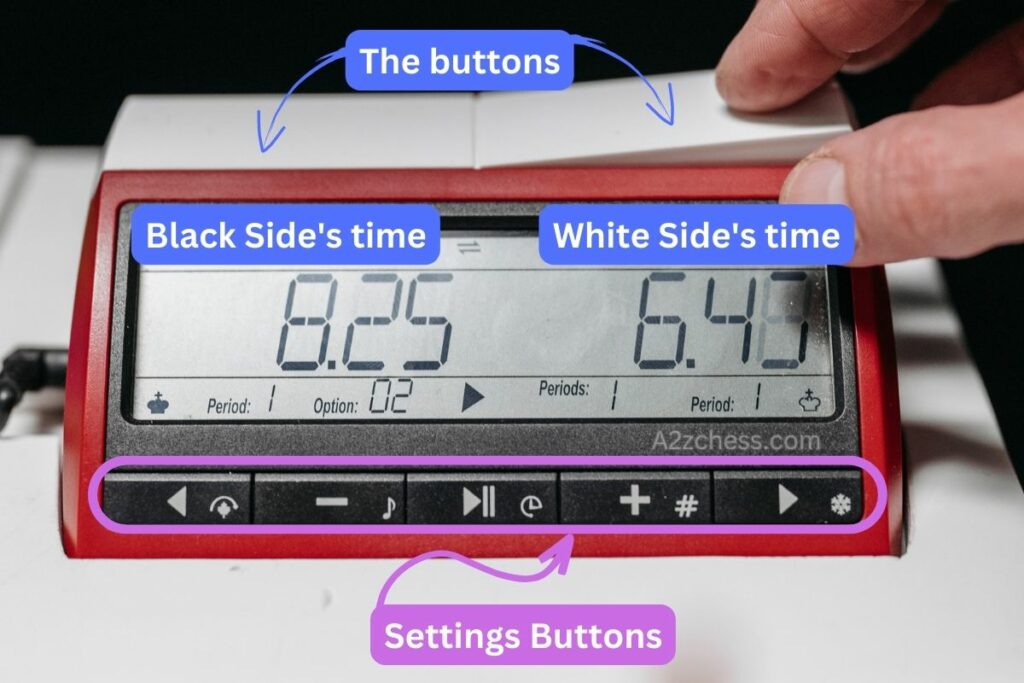
Time is measured during chess games using chess clocks, which have two separate timers, one for each player, connected to a single device.
When a player makes their move, they physically move a piece on the chessboard and then press a button or lever on their side of the clock to stop their timer and start the opponent’s timer simultaneously. This action signals the end of the player’s turn and the beginning of the opponent’s turn.
While the opponent is contemplating their move, their timer is running, and the time remaining is displayed on the clock. The player has to make their move before their time runs out to avoid losing the game on time.
The time controls, as mentioned earlier, determine the initial amount of time allocated to each player. This could be a fixed amount for the entire game, such as in the classic time control, or it could be a specific amount per move, like in time controls with increments or delays.
During the game, players are responsible for managing their own time, monitoring their remaining time on the clock, and ensuring they make their moves within the given time limits. This adds an additional strategic element to chess.
Who Starts the Clock in Chess?
The responsibility for starting the clock typically falls on the player whose turn it is to make a move. This ensures a fair and consistent way to measure time usage during a game. It also prevents any potential confusion or disputes regarding whose turn it is or whether a move has been made.
At the start of the game, the player playing the black side has to press the clock so the game starts. In significant chess events, the arbiter or a guest of honor will usually do that in the presence of media.
Sometimes, the guest will also play the first move (after the player tells them what move to play).
Here is an example of the 2021 WCC:
What Is the Average Time It Takes to Make a Move in Chess?

The average time it takes to make a move in chess can vary significantly depending on various factors.
In casual games or friendly matches, players typically take their time to analyze the position, consider different options, and make more thoughtful moves. In such cases, moves can take several minutes or even longer, especially for critical or complex positions where players want to ensure they make the best move possible.
On the other hand, in tournaments, there are time controls in place to maintain the pace of the game, which determine the average time spent per move.
For example, in a standard time control with 90 minutes for the entire game, players may spend an average of a few minutes per move. However, in faster time controls, such as rapid, blitz, or bullet chess, players are required to make decisions more quickly, so moves may take anywhere from a few seconds to a minute or two on average.
It’s important to note that these estimates are general and can vary widely depending on individual playing styles, the complexity of the position, and the players’ skill level.
Some players may make moves more swiftly, relying on intuition and pattern recognition, while others may take more time to deeply analyze the position and calculate variations.
What Happens If You Take Too Long to Make Your Move?
If a player takes too long to make their move and exceeds the time allocated to them according to the time control rules, they may face penalties or consequences depending on the specific regulations in place. Here are the potential outcomes:
- Time Expired: If a player’s time runs out before they make their move, they typically lose the game on time, regardless of the position on the board. This means their opponent wins, even if they had a disadvantageous position at that point.
- Penalties: In certain tournaments or under specific time control rules, there may be penalties for repeatedly exceeding the allocated time. For example, the player may lose a certain amount of additional time or face point deductions, depending on the tournament regulations. This is exceedingly rare and is almost never heard of in today’s world thanks to the accuracy and reliability of digital clocks.
- Arbitrator’s Discretion: In some cases, an arbiter or tournament director may have the discretion to intervene if a player consistently takes excessive time or abuses the time control rules. They can issue warnings, implement stricter penalties, or even disqualify a player if necessary.
Is There Overtime in Chess Tournaments?
Overtime or additional time provisions are commonly used in chess tournaments to handle situations where players have limited time left on their clocks.
There are two primary types of overtime commonly used in chess tournaments:
Increment
Increment, also known as bonus time or Fischer time, is a time control feature where each player receives an additional amount of time added to their clock after each move they make.
For example, with a 5-second increment, a player would gain 5 seconds on their clock after every move they play. This extra time helps prevent players from running out of time quickly and allows for a more gradual depletion of time.
Delay
Delay, also referred to as Bronstein delay, is a time control mechanism where a small amount of time is added to a player’s clock before their timer begins counting down after each move.
For example, with a 3-second delay, a player’s timer does not start counting down until 3 seconds have passed since their previous move. The delay gives players a small buffer before their time starts ticking, allowing them to have a moment to think before their clock begins to decrease.
Both increment and delay time controls provide players with additional time during the game, ensuring that they have some leeway to make their moves without risking an immediate loss due to time constraints. These overtime provisions are particularly useful in rapid, blitz, and bullet chess, where time pressure is significant.
What Happens If A Chess Game Is Taking Too Long?
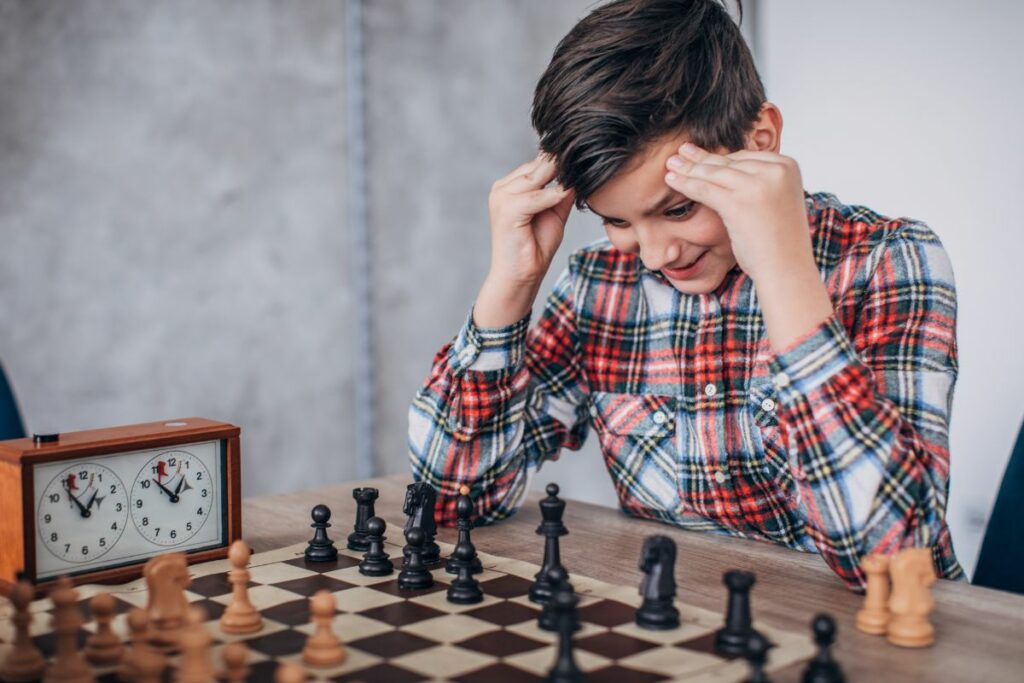
If a chess game is taking too long and it is causing delays or disruptions to the tournament or event, organizers may take measures to encourage a timely conclusion.
Here are some actions that can be taken:
- Tournament Director’s Intervention: The tournament director or arbiter has the authority to intervene if a game is excessively time-consuming. They may observe the game, assess the situation, and, if necessary, encourage the players to expedite their moves.
- Warning or Penalties: If players consistently take excessive time or intentionally delay the game (especially if they do so unnecessarily), they may receive warnings or penalties. This can include point deductions, additional time penalties, or other consequences as per the tournament regulations.
- Offering a Draw: In situations where both players are unable to make progress or reach a decisive outcome, one player may offer a draw to the opponent. If the opponent accepts the draw offer, the game ends immediately, ensuring a resolution without prolonging the game unnecessarily.
- Adjusting Time Controls: In some cases, if games are consistently taking too long, organizers may consider adjusting the time controls for future rounds or implementing faster time controls to maintain the pace of play and prevent significant delays.
Before the rise of computer engines, another option was the most common: Adjournment.
- Adjournment: If a game is approaching a predetermined time control or the tournament’s time limit, organizers may allow players to adjourn the game, which means the game will be paused and resumed at a later time, typically on a different day. Tournaments stopped using Adjournment in 1996 to stop cheating.
What Is the Longest Game of Chess Ever Played?
The longest recorded game of chess was played between Ivan Nikolic and Goran Arsovic in Belgrade, Serbia, in 1989, and it became known as the “Belgrade Marathon.” It was played using the traditional time control, where players had a fixed amount of time for the entire game without any increments or delays.
The game lasted for a staggering 269 moves and took over 20 hours to complete. Unfortunately, it ended in a draw due to the fifty-move rule, as neither player was able to checkmate the other or make progress in the position.
It’s worth noting that this specific game’s length is exceptional and not representative of the average duration of chess games. Most games, even in top-level tournaments, typically conclude within a few hours, especially when using faster time controls.
So, the “Belgrade Marathon” remains a notable and memorable example of the extraordinary lengths to which players can go in their pursuit of victory on the chessboard.
Conclusion
The evolution of time controls in chess has not only enhanced the organization and efficiency of tournaments but has also added new dimensions to the game.
As an aspiring chess player, you must now master the art of managing your time effectively, balancing the need for thorough analysis with the pressure to make timely decisions.
Now go out there and crush it!
If you did find this article helpful, please consider sharing, as it can help this little site grow 🙏

